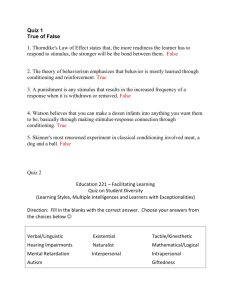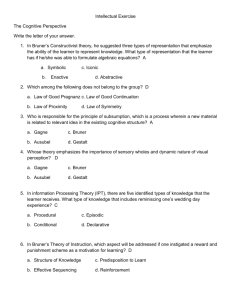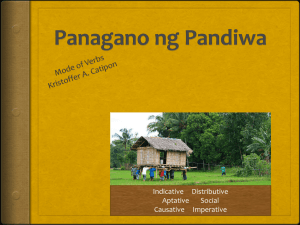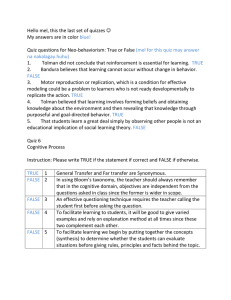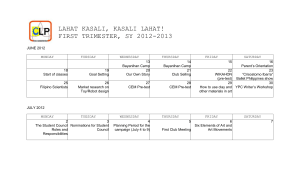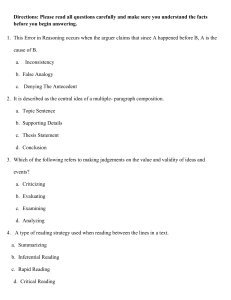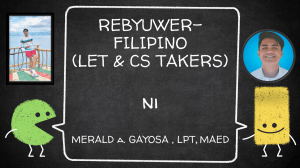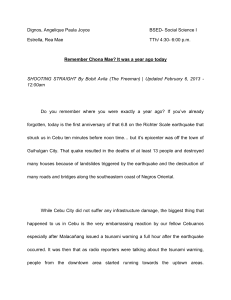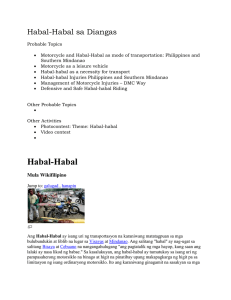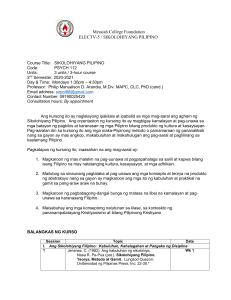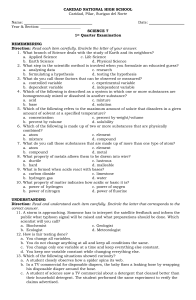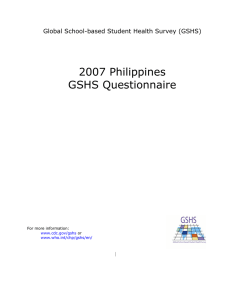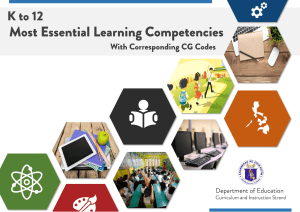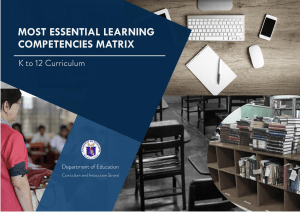True of False - ee
advertisement
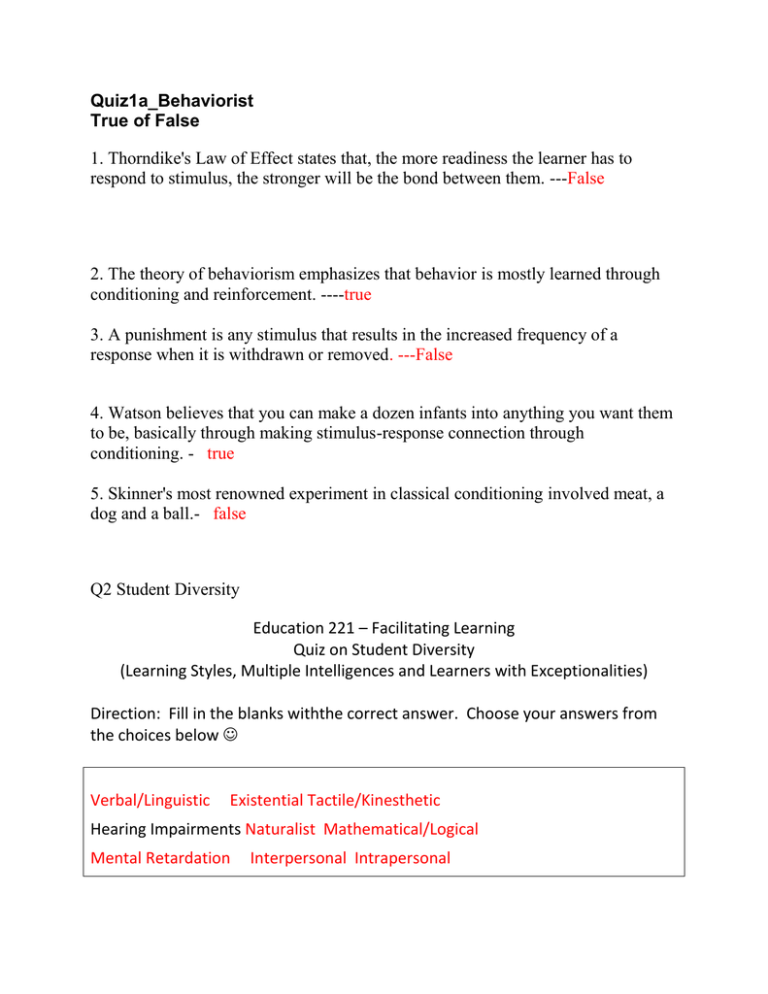
Quiz1a_Behaviorist True of False 1. Thorndike's Law of Effect states that, the more readiness the learner has to respond to stimulus, the stronger will be the bond between them. ---False 2. The theory of behaviorism emphasizes that behavior is mostly learned through conditioning and reinforcement. ----true 3. A punishment is any stimulus that results in the increased frequency of a response when it is withdrawn or removed. ---False 4. Watson believes that you can make a dozen infants into anything you want them to be, basically through making stimulus-response connection through conditioning. - true 5. Skinner's most renowned experiment in classical conditioning involved meat, a dog and a ball.- false Q2 Student Diversity Education 221 – Facilitating Learning Quiz on Student Diversity (Learning Styles, Multiple Intelligences and Learners with Exceptionalities) Direction: Fill in the blanks withthe correct answer. Choose your answers from the choices below Verbal/Linguistic Existential Tactile/Kinesthetic Hearing Impairments Naturalist Mathematical/Logical Mental Retardation Interpersonal Intrapersonal Autism Giftedness Attention-Deficit-Hyperactivity-Disorder (ADHD) 1. __ Interpersonal _______________________Michael likes going out and being with others at parties and other social events. 2. Verbal/Linguistic _________________________Ma’am Lopez can easily express herself, whether verbal or written. She gives instructions which are easily understood by her students. 3. _ Mental Retardation _____________________It refers to significant subaverage intelligence and deficits in adaptive behavior. There is difficulty in managing activities of daily living and in conducting themselves appropriately in social situations. 4. _ Existential ________________________She always prefers to spend time reflecting about herself and think of the significant aspects of her life. 5. __ Autism _____________________Persons with this condition may exhibit repeated body movements (hand flapping, rocking), unusual responses to people or attachments to objects and resistance to changes in routines. Individuals may also experience sensitivities in the five senses of sight, hearing, touch, smell and taste. 6. __ Naturalist _______________________English, languages and literature are my friend’s favorite subject at school. _ Intrapersonal 7. ________________________She would rather study alone than join a group study. 8. Tactile/Kinesthetic _________________________These learners typically learn best by doing. They usually have good motor memory and motor coordination. 9. __ Attention-Deficit-Hyperactivity-Disorder (ADHD) _______________________An individual with this condition finds it much more difficult to focus on something without being distracted. Usually, he is impulsive and restless. 10._ Mathematical/Logical math. ________________________My brother loves Quiz3a- cognitive 1. Social constructivism was based on Erikson’s Socio- Cultural theory. His theory emphasized that effective learning happens with social interaction.-false 2. In constructivism theory, learning becomes more meaningful when a learner is given the opportunity to explore, discover and construct his own knowledge.-true 3. A constructivist teacher is an expert who knows everything and the student’s learning depends on him.-false 4. Transfer of learning happens when a learner discovers the connection of hispreviously learned knowledge to other situation or learning.-true 5. A negative transfer of learning happens when learning in a certain context delays or hinders learning in a different situation.-true Q4blooms taxonomy Instruksyon: Basahin at unawain ang mga sumusunod na layunin sa pagtuturi at uriin ito. Titik lamang ng sagot ang isusulat sa kahon bago ang bilang ng katanungan. a. b. c. d. e. f. e a b c a f d b e d Remembering Understanding Applying Analyzing Evaluating Creating 1. Maisa-isa ang sariling mga argumento upang mabigyang diin kung bakit di dapat maipalabas ang pelikulang Da Vinci Code dito sa Pilipinas. 2. Makakakalap ng mga mga pananaw ng iba upang makabuo argumento sa talumpati kung bakit di dapat ipalabas ang pelikulang Da Vinci Code dito sa Pilipinas. 3. Mabigyang depinisyon ang wikang Filipino bilang wikang pambansa at wikang transaksyunal. 4. Maisagawa nang aktwal ang proseso ng pagbasa sa pamamagitan ng pagbabasa ng isang teksto at pagtukoy sa mga komponent ng proseso nito. 5. Mapangalanan ang iba’t ibang grap na ipinaskil sa pisara. 6. Makabuo ng isang talahanayan (table) tungkol sa kasarian (gender) ng lahat ng mag-aaral sa klasrum nito. 7. Makapaghinuha sa maaaring susunod na mangyayari sa ukol sa Audio/Visual na kwento na ipapakita/ipinarinig sa klase batay sa mga katotohan at/o naunang pangyayaring napanood sa Audio/Visual. 8. Maipaliwanag ang pagkakaiba ng opinyon at katotohanan. 9. Masuri ang isang ideya kung ito ba ay isang opinyon o katotohanan. 10.Makapagkumpara at kontas sa pangangatwirang dedaktib at indaktib. Q5Devt theories DEVELOPMENTAL THEORIES A. Piaget's Cognitive Development B. Erikson's Psychosocial Theory of Development C. Kohlberg's Theory of Moral Development D. Vygotsky's Socio-Cultural Theory Identify the theory of development expressed in the following statements. (Write only the letters of your answer.) 1. The principal goal of education is to create men who are capable of doing new things - men who create, invent, and discover.---A 2. The theoretical framework is genetic epistemology - how knowledge developed in human organisms.----A 3. Egocentricism is the tendency of the child to only see his point of view and to assume that everyone else has his same point of view.----A 4. Healthy children will not fear life if their elders have integrity enough not to fear death.----B 5. The theory highlights the influence of one's environment particularly on how earlier experiences gradually build upon the next and result into one's personality.B 6. Virtue is a psychosocial strength which will help people through the rest of their lives.-B 7. Our ability to choose right from wrong is tied with our ability to understand and reason logically.C 8. At the center of the approach implementation is a community meeting in which issues related to life and discipline in the schools are discussed and democratically decided, with an equal value placed on the voices of students and teachers.-C 9. In Social Approval, the person will follow the law because of what others expect.-C 10. Social interaction and language are two central factors in the development of an individual.-D Q6 Cognitive Process Quiz Cognitive Process Instruction: Please write TRUE if the statement if correct and FALSE if otherwise. True False 1 2 False 3 False 4 False 5 General Transfer and Far transfer are Synonymous. In using Bloom’s taxonomy, the teacher should always remember that in the cognitive domain, objectives are independent from the questions asked in class since the former is wider in scope. An effective questioning technique requires the teacher calling the student first before asking the question. To facilitate learning to students, it will be good to give varied examples and rely on explanation method at all times since these two complement each other. To facilitate learning we begin by putting together the concepts (synthesis) to determine whether the students can evaluate situations before giving rules, principles and facts behind the topic. Q7 Intellectual Exercise The Cognitive Perspective Write the letter of your answer. 1. In Bruner’s Constructivist theory, he suggested three types of representation that emphasize the ability of the learner to represent knowledge. What type of representation that the learner has if he/she was able to formulate algebraic equations? ---A a. Symbolic c. Iconic b. d. Abstractive Enactive 2. Which among the following does not belong to the group? ---D a. Law of Good Pragnanz c. Law of Good Continuation b. Law of Proximity d. Law of Symmetry 3. Who is responsible for the principle of subsumption, which is a process wherein a new material is related to relevant idea in the existing cognitive structure? --- B a. Gagne c. Bruner b. Ausubel d. Gestalt 4. Whose theory emphasizes the importance of sensory wholes and dynamic nature of visual perception? --- D a. Gagne c. Bruner b. Ausubel d. Gestalt 5. In information Processing Theory (IPT), there are five identified types of knowledge that the learner receives. What type of knowledge that includes reminiscing one’s wedding day experience? ---C a. Procedural c. Episodic b. Conditional d. Declarative 6. In Bruner’s Theory of Instruction, which aspect will be addressed if one instigated a reward and punishment scheme as a motivation for learning? --- D a. Structure of Knowledge c. Predisposition to Learn b. Effective Sequencing d. Reinforcement 7. What type of advance organizer that looks over a new material in order to extract the general thought?--- C a. Narrative c. Skimming b. Expository d. Graphic 8. What theory emphasizes the need for different internal and external conditions for each type of learning? ---A a. Gagne c. Bruner b. Ausubel d. Gestalt 9. In Gagne’s Conditions for Learning, what event of instruction was used when the teacher asked the student to a recapitulation of a previous lesson? ---C a. Presenting the Stimulus learning c. Stimulating recall of prior b. Gaining Attention d. Providing learner guidance 10. Which law or principle in Gestalt’s psychology that focuses on the perception of similar elements being part of the same form? --- B a. Law of Proximity c. Law of Good Continuation b. Law of Similarity d. La w of Closure Choices 1. assigning appropriate challenges 2. environment 3. fairness and respect 4. social interactions with students 5. Caring 6. Reflective Practices Choose from the choices above. Write only the number of your answer. 1 2 is defined as the sum total of one’s surrounding 2 5 sympathetic listening to students lives 3 3 treating students as people 4 4 friendly personal manner while maintaining professional distance 5 1 enthusiasm and motivation for learning 6 6 reviewing and thinking teaching processes
